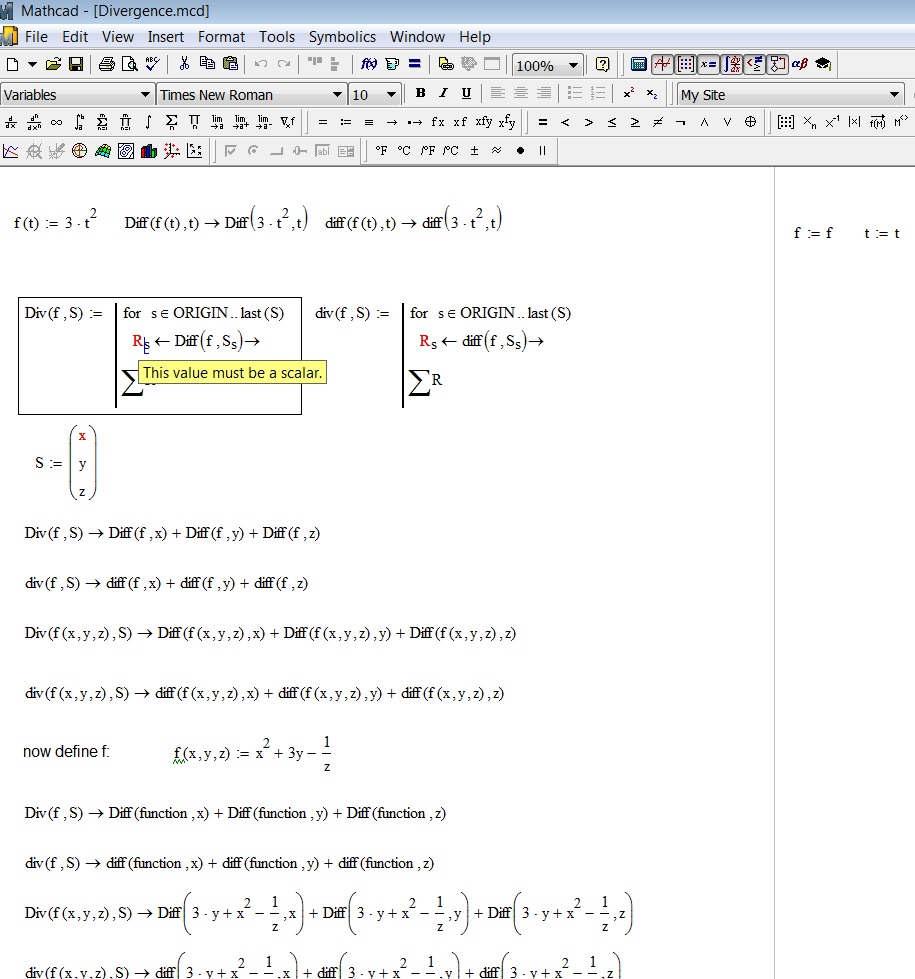- Subscribe to RSS Feed
- Mark Topic as New
- Mark Topic as Read
- Float this Topic for Current User
- Bookmark
- Subscribe
- Mute
- Printer Friendly Page
From MKS to GAUSS system E.M. fields transformations
- Mark as New
- Bookmark
- Subscribe
- Mute
- Subscribe to RSS Feed
- Permalink
- Notify Moderator
From MKS to GAUSS system E.M. fields transformations
Goodmorning everyone!
Is there anyone who can fix this little problem?
Thanks a lot.
F. M.
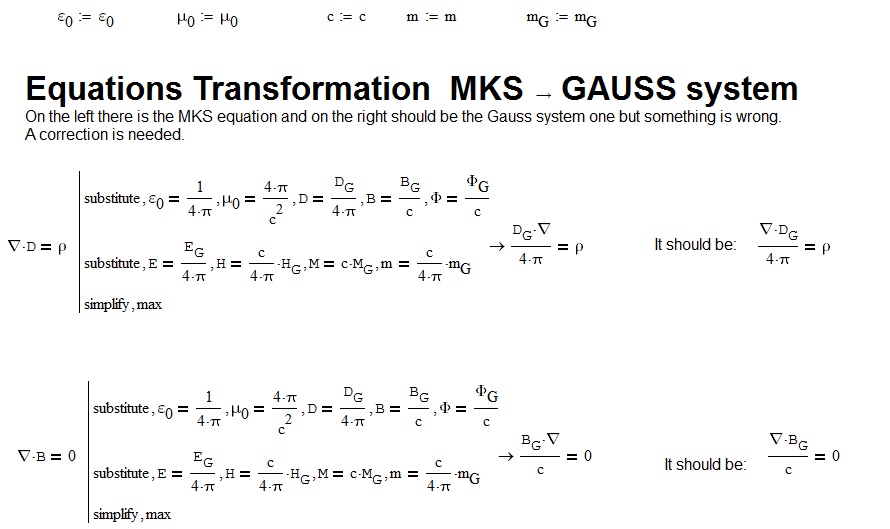
- Labels:
-
Other
- Mark as New
- Bookmark
- Subscribe
- Mute
- Subscribe to RSS Feed
- Permalink
- Notify Moderator
Yes it is not a man - it is a competer ![]()
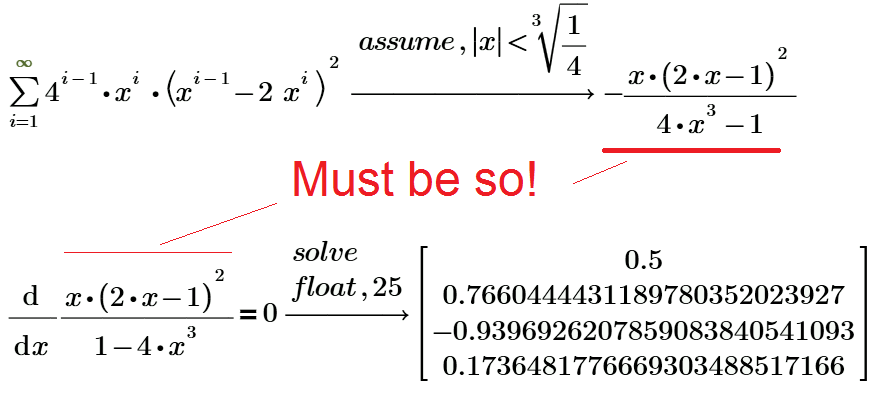
- Mark as New
- Bookmark
- Subscribe
- Mute
- Subscribe to RSS Feed
- Permalink
- Notify Moderator
What........?????
- Mark as New
- Bookmark
- Subscribe
- Mute
- Subscribe to RSS Feed
- Permalink
- Notify Moderator
F.M. wrote:
What........?????
Sorry, what what???
- Mark as New
- Bookmark
- Subscribe
- Mute
- Subscribe to RSS Feed
- Permalink
- Notify Moderator
...The answer does not comply with the question ...
- Mark as New
- Bookmark
- Subscribe
- Mute
- Subscribe to RSS Feed
- Permalink
- Notify Moderator
I assume your divergence operator is custom defined by yourself (or else please point me where I can find it in Mathcad). Then it is defined as a variable...
Mathcad provides little to no control on the sequence of variables in the output of symbolic evaluation.
You might get by, when you use the divergence operator as an operator (i.e. as a function). I tried this in Mathcad 11 (with the operator/function 'div' undefined ! 😞

Success!
Luc
- Mark as New
- Bookmark
- Subscribe
- Mute
- Subscribe to RSS Feed
- Permalink
- Notify Moderator
I believed that it was not necessary (required) to indicate the lower placeholder. In some previous version of mathcad, if I remember right, (I did not check) there was not.
In short, without the lower placeholder, the operator does not work?
Since I have many worksheets that use that operator, I would like to continue to keep it without having to change everything but only the definitions.
- Mark as New
- Bookmark
- Subscribe
- Mute
- Subscribe to RSS Feed
- Permalink
- Notify Moderator
What 'lower placeholder' are you referring to?
I used the ' x f ' out of:

to build the LHS of my second equation. But you can see what the symbolic processor returns as output.
In any case, this is mathematically correct.
I still think you used the divergence symbol (only) as a variable, am I right?
Incidentally, where did you find the divergence symbol?
- Mark as New
- Bookmark
- Subscribe
- Mute
- Subscribe to RSS Feed
- Permalink
- Notify Moderator
The DEL" is aa gradient function in Mathcad 15, "cntrl-shift-G". I haven't found it in Prime
- Mark as New
- Bookmark
- Subscribe
- Mute
- Subscribe to RSS Feed
- Permalink
- Notify Moderator
Ah, Thanks Fred.
It doesn't exist as such in Mathcad 11. I don't have 15 at hand.
- Mark as New
- Bookmark
- Subscribe
- Mute
- Subscribe to RSS Feed
- Permalink
- Notify Moderator
If I remember correctly in version 12, it was present.
- Mark as New
- Bookmark
- Subscribe
- Mute
- Subscribe to RSS Feed
- Permalink
- Notify Moderator
I refer to this:

They have impressed me these results:
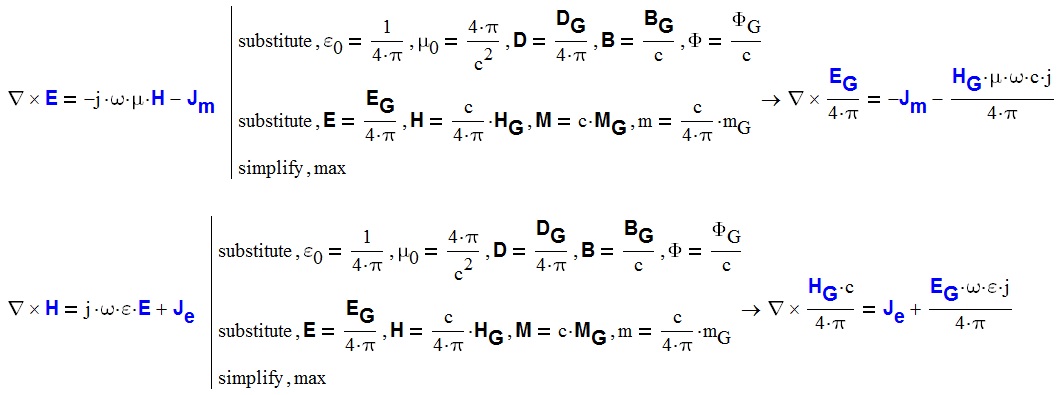
I have to check the accuracy of the results.
- Mark as New
- Bookmark
- Subscribe
- Mute
- Subscribe to RSS Feed
- Permalink
- Notify Moderator
....have not found them, I've built myself.
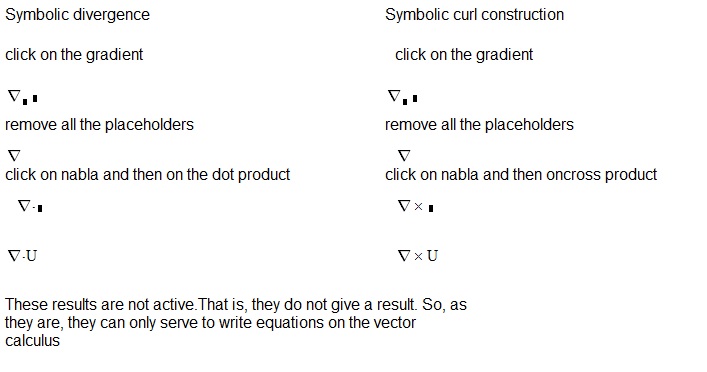
- Mark as New
- Bookmark
- Subscribe
- Mute
- Subscribe to RSS Feed
- Permalink
- Notify Moderator
I'm surprised it let's you delete the placeholders. At any rate, when you do you are left with a variable.
- Mark as New
- Bookmark
- Subscribe
- Mute
- Subscribe to RSS Feed
- Permalink
- Notify Moderator
I think that this happens in any computer, not just in my computer!?!?
- Mark as New
- Bookmark
- Subscribe
- Mute
- Subscribe to RSS Feed
- Permalink
- Notify Moderator
I can also delete the placeholders. There is no other operator that allows me to do that though.
- Mark as New
- Bookmark
- Subscribe
- Mute
- Subscribe to RSS Feed
- Permalink
- Notify Moderator
Excuse me Mr. Valery, if I insist. But your answer has a darker meaning. I probably disturbed someone? I am not aware. Then?
- Mark as New
- Bookmark
- Subscribe
- Mute
- Subscribe to RSS Feed
- Permalink
- Notify Moderator
Thinking about it, with regard to the divergence operator, since I used the dot product, which is commutative (while the vector product is not) the program (considering both arguments as vectors) swaps the operator (seen as a vector) with the vgiven ector. Swapping that is not valid for the vector product.
- Mark as New
- Bookmark
- Subscribe
- Mute
- Subscribe to RSS Feed
- Permalink
- Notify Moderator
You are right, that you can omit/delete the placholder for the variable in the gradient operator. But it seems that you deleted the placeholder for the function, too, and so you end up as Richard already stated with a simple variable. You see the multiplication dot between the nabla-symbol and the variable D or B.
I am not sure what you expected the nabla-symbol to be. Mathcad obviously gives you the result you expected anyway as the order of the operands in a product does not matter.

- Mark as New
- Bookmark
- Subscribe
- Mute
- Subscribe to RSS Feed
- Permalink
- Notify Moderator
Thanks for the examples. I know what is written in the guide, and I've taken into account.
I use these operators since I was a boy.
The symbol is called nabla and it defines the gradient operator acting on a scalar.
Similarly to what is realized in mathcad for it, I would like to define the other two vector operators with the use of nabla: divergence and rotor that act on vectors.
- Mark as New
- Bookmark
- Subscribe
- Mute
- Subscribe to RSS Feed
- Permalink
- Notify Moderator
If you know all what was written already I wonder, why you ask

You should also know that we have in general very few influence on the way Mupad presents its results and how it arranges its variables.
And the nabla symbol the way you used it is just a variable,, not an operator!
- Mark as New
- Bookmark
- Subscribe
- Mute
- Subscribe to RSS Feed
- Permalink
- Notify Moderator
... I thought that, despite nabla was considered as a variable, the processor had not swapped the two variables in such a way that the equation formally was correct. As are formally correct the following:

- Mark as New
- Bookmark
- Subscribe
- Mute
- Subscribe to RSS Feed
- Permalink
- Notify Moderator
I see - basically in great parts you are using Mathcad simply as an equation editor, so making nabla a variable does not harm if you connive at the (implicit or explicit) multiplication after the symbol. But when it comes to symbolic math, you run into troubles. While I doubt its a good idea making the nabla operator a varible, may the keyword "collect" helps.
Sometimes you are able to take influence on the outcome that way:

- Mark as New
- Bookmark
- Subscribe
- Mute
- Subscribe to RSS Feed
- Permalink
- Notify Moderator
As you can see in the previous immage, I have formatted nabla as a vectorial operator and not as a simple variable. However, it does not match any operation on vector ..
I like to do the works presentable, who have a "head" and a tail. Throw there, formulas that no one understands, I do not like, then the formulas are necessarily accompanied by text. It seems obvious!
- Mark as New
- Bookmark
- Subscribe
- Mute
- Subscribe to RSS Feed
- Permalink
- Notify Moderator
> As you can see in the previous immage, I have formatted nabla as a vectorial operator and not as a simple variable.
I was not talking about how YOU see the symbol but how Mathcad sees it. If you want Mathcad to see it as a functional operator, you are not allowed to delete the placeholder for the function! Otherwise all you get is a multiplication of a variable (or a vector in case of the vector product) with a function.
- Mark as New
- Bookmark
- Subscribe
- Mute
- Subscribe to RSS Feed
- Permalink
- Notify Moderator
alles klar!
Danke.
Tschüss
- Mark as New
- Bookmark
- Subscribe
- Mute
- Subscribe to RSS Feed
- Permalink
- Notify Moderator
The answer of Luke Meeks would be fine if I did not want to use nabla. That, however, I will. So far, there is no right answer.
- Mark as New
- Bookmark
- Subscribe
- Mute
- Subscribe to RSS Feed
- Permalink
- Notify Moderator
I think the closest you can get is to use the cross-product operator:

And I find the prefix notation result, with the nabla operator, intriguing.
Success
Luc
- Mark as New
- Bookmark
- Subscribe
- Mute
- Subscribe to RSS Feed
- Permalink
- Notify Moderator
OK. the nabla symbol is not available in Mathcad 11, but,
using the undocumented symbolic functions Diff() and diff()
that produce respectively calculate (partial) derivatives of
the (assumed function) first parameter to the second parameter:

you can get this:

For those who can benefit from it.
- Mark as New
- Bookmark
- Subscribe
- Mute
- Subscribe to RSS Feed
- Permalink
- Notify Moderator
Mathcad 15 results:
